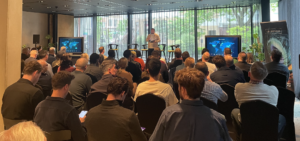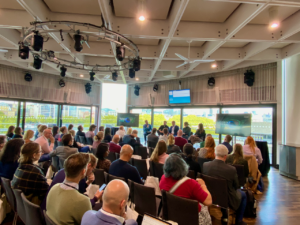With over 20 different agency models out there, we gathered together brand-side marketers, business models transformers, pricing guru’s, procurement consultants and agency new business experts to unpack and debate the topic in three key areas – understanding why and how client needs are changing, how agency models are changing to better serve these needs and how to adopt new pricing models and sell in your agency proposition.
Keeping up with changing client needs
In Part 1 of our event wrap up from ‘The Evolution of Agency Models’ we explore changing client needs and how this is impacting the way in which they work with agencies.
Client-side transformation
We kicked off the morning unpacking the drivers for change client-side, and explored some of the ways brand are re-thinking and re-shaping how they work with agencies.
Meet our panel:
- Kim Stoute-Purvi, Senior Global Head of Integrated Marcomms (Retail Business), Shell
- Gellan Watt, Chief Commercial Officer, Forward – lastminute.com’s Media Agency
- Rob Connolly, Director, The Business Model Co
What’s changing client-side to drive a shift in client-agency relationships?
Kim from Shell shared the journey that the business has been on to develop their ‘Agency of Future’ model which moves away from a traditional lead-agency model to a collective of best in class agencies.
The move to implement this new model was driven by substantial changes within the business, combined with the fact that it had been 15 years since the last agency review. It was time to refresh the model and make sure that agencies were aligned with what the business needs were today.
We have changed so much as a business, we needed to find agency partners who understood who we are now and where we are going.
Business Model Transformation Expert, Rob Connolly, says that he is seeing genuine evolution within brands at the moment, and this is fundamentally impacting on how they engage agency partners.
He spoke about one of the key drivers being around increasing flexibility – clients are demanding more flexibility than ever from agencies which is evident in the decline of retained work being commissioned. Clients just aren’t in a position to commit to 12 / 18 months of scope upfront anymore. He cautioned that it doesn’t necessarily mean that they’re not committed to their agency partners, but they need flexible models to buy what they need at the point they need it.
Gellan shared the story of how lastminute.com have built their in-house media agency, of which he said the main driver wasn’t just cost savings, but also efficiency. While in-housing isn’t for every brand, there is an opportunity for some businesses to bring certain services in-house. He spoke about the model not being an ‘in or out’ scenario, it is a strategy not a tactic, it’s about changing the way business is done. And rest assured agency partners, while some services have moved in-house the travel brand still work with multiple agencies to deliver different aspects of the marketing mix.
How has tech played a role in changing client needs?
A question from the audience explored what the impact of technology has been on clients being able to serve their needs internally.
Gellan said that with a lot of more agile businesses we’re seeing tech that would usually sit agency-side move in-house. He said that smart businesses are realising they can adopt tech that allows them to own the conversation around their data, but that he also believes that there is an opportunity for brave agencies to help their clients set up their own tech in-house. When the client owns the data it can can actually lead to much better relationships with agencies.
If the client manages the commoditised services themselves it leaves opportunities for agencies to reposition their offering towards becoming a strategic partner who can add value through ideas and creativity. Ideas and creativity will always have an exponential value.
Kim’s view on the topic was much different, saying that a large business like Shell is much slower and everything is still outsourced. At the moment they lack the fluidity and nimbleness to bring tech in-house and still look to their agencies for data and tech.
It’s clear that access to technology is impacting the way that brands structure their internal teams and outsource to agencies, however, the model is much better suited to digital or nimble businesses, the larger enterprise-level businesses will take a lot longer to evolve.
Why has demonstrating value become so important for agencies?
Agencies must get better at demonstrating and communicating the value that they add.
Outcome and output pricing is going to continue to become a key area of focus for brands which means that agencies must get better at demonstrating and communicating the value that they add.
Rob Connolly spoke about value in the context of what he believes clients want – creativity at scale. And for agencies to be in a position to deliver creativity at scale they must attract and retain better talent. To do this they need better margins to be able to re-invest.
There needs to be a shift to where brands recognise that they must help agencies get better, and to facilitate this shift there needs to be a change in conversation. You guessed it, the conversation must move to talking more about value.
Gellan echoed Rob’s point, and issued a warning for agencies relying on selling commodity-based services or who aren’t currently delivering outputs that aren’t clearly demonstrating value for the client – you’re in danger, it’s more important than ever to demonstrate the value you bring.
Making this shift is no small feat. Rob shared two tips for agencies wanting to bring about change.
Pick one client who is a little more open-minded and who isn’t solely focused on driving down cost. Begin to change the conversation with them from time to value-based outputs. Once you have an instance where you have forged and developed a relationship and remuneration model based on value, not time, you can use it as a case study to take to other clients to start widened your conversations.
Secondly, so many agencies are losing out because the first conversation they’re having about value is at pitch stage said Rob. If the first time you’re talking about value is when an RFP has landed on your desk then you have already missed the boat. You’re landing too late and it’s a lot harder to shift the conversation at that stage in the game. Get in early to build genuine relationships with your potential new client and demonstrate the value and insight you have from day one.
What does it all mean for agencies?
It’s a good time for indies
Kim commented that indies bring something that the networks can’t always do and they often have a completely different point of view.
Rob agreed, he works with some huge brands, and when he first started working with them it was genuinely almost impossible for indies to get in the door. But he has seen a significant shift in the way that brands think and he is seeing more and more brands pick agencies if it’s the right partnership for the brief – regardless of whether they’re an indie or network. Brands are genuinely changing and indies have an important role to play in the future agency landscape.
Stop selling on time
We spoke a lot about value during the event and it is clear that to move away from selling purely on time, that agencies must get better at communicating the value that they bring. The overwhelming advice for agencies was to start moving away from relying on selling commoditised services, with more and more clients looking to take things in-house or scale back agency work, the opportunity for agencies lies in flexibility, value and creativity.
You can’t stand still
Kim warned agencies against being complacent – especially if you’re the incumbent and the client is going back out to market. She also said that she was surprised by the lack of questions from agencies during the pitch process – it shouldn’t be seen as a sign of weakness, it demonstrates that you’re committed and invested.
It is clear that there is an appetite from clients to change, and that this change needs to take place on both sides. With so many different models available, the main thing is that agencies can’t stand still, they must join the conversation, those who stand still just won’t survive.
The next article in our series looks at the evolution of client-agency models through the agency lens. We take a look at all of the different models we’re now seeing and share the quick wins of how to change.




